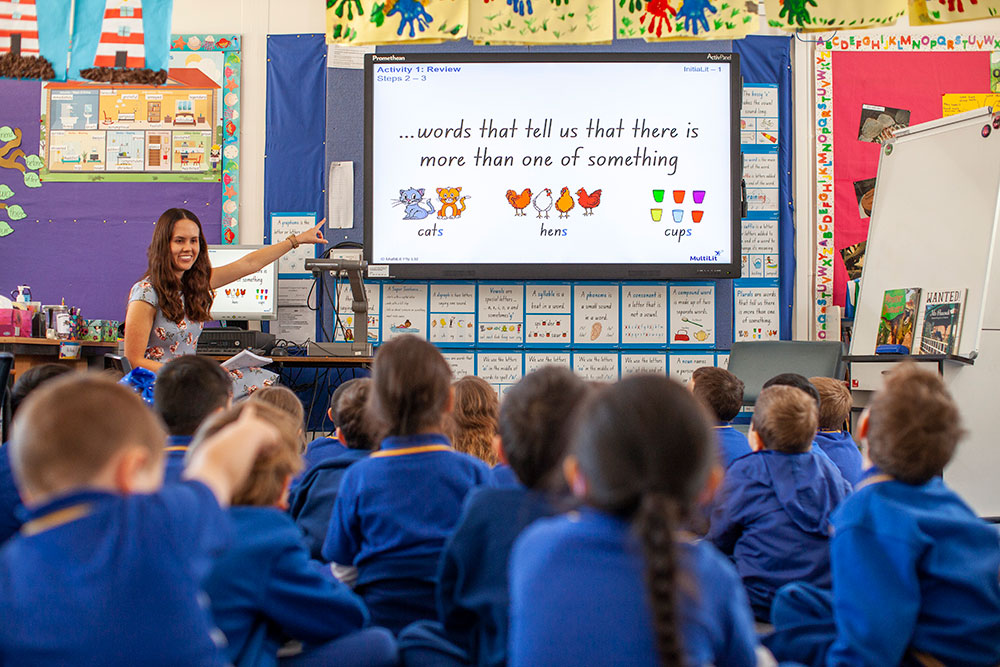Delivering the curriculum

In light of the introduction of Version 9.0 of the Australian Curriculum, and state-specific changes such as the NSW Curriculum Reform, teachers are asking how InitiaLit and other MultiLit programs align with the new curricula. MultiLit has assessed the impact of these changes, and can reassure teachers that after mapping our programs against the new curricula, MultiLit programs will continue to meet the needs of schools.
 How can MultiLit help teachers deliver the new English curriculum?
How can MultiLit help teachers deliver the new English curriculum?
MultiLit has a comprehensive suite of complementary programs which align with the new Australian curriculum, including whole-class instruction for Foundation to Year 2 with InitiaLit, based on the science of how children learn to read.
Are InitiaLit and the new curriculum based on the same research?
MultiLit’s programs are all underpinned by multi-disciplinary scientific research on how people learn to read and how to teach reading effectively. This extensive research has shown that there are five essential skills for reading: phonemic awareness, phonics, fluency, vocabulary and comprehension. MultiLit’s programs address all five components (‘the Five Big Ideas’), incorporating a systematic, synthetic approach to phonics, as well as oral language.
It is exciting to now see the science of reading being incorporated into the curricula being implemented, with the Five Big Ideas among the key areas of understanding outlined in the new NSW English K–2 Syllabus.
The science of reading concepts embraced in the new curriculum – including the Simple View of Reading, Scarborough’s Reading Rope, oral language and explicit phonics instruction – underpin our programs, making teachers of InitiaLit best-placed to deliver the new syllabus and its expected outcomes.

Does InitiaLit only teach phonics? What about oral language and writing?
MultiLit’s programs take a phonics-based approach to teaching reading and writing, as well as working to develop oral language, comprehension and vocabulary skills.
The new NSW K–2 English Syllabus covers content including oral language and communication, handwriting, spelling and creating written texts, which are addressed in all three levels of InitiaLit. Children are explicitly taught the mechanical aspects of writing, including handwriting and spelling, and also create texts within InitiaLit lessons in dictation, grammar, spelling and extended writing tasks.
InitiaLit provides space for adjusting lessons for the needs of students, or for providing additional programming outside of scripted lessons.
I’ve heard the NSW syllabus suggests a different phonics instructional sequence to InitiaLit. What does that mean for schools using InitiaLit?
During the first three years of schooling, it is vital to establish a solid understanding of how the alphabetic code works.
It is not unusual for different phonics programs to use their own scope and sequence. Beyond certain principles that need to be considered, there isn’t one perfect, definitive sequence. The power of a sequence is that you are building knowledge in a logical, efficient way, from easier to grasp concepts to harder aspects.
There are some minor differences in the instructional sequence of the new NSW syllabus and the order this information is delivered in InitiaLit. For example, the NSW K–2 English syllabus introduces the split digraph in the Foundation year, while this is not explicitly taught until InitiaLit-1. Teachers can introduce the split digraph when it arises during reading in the Foundation year, incidentally and as needed. These will be revisited in InitiaLit-1 where they are taught at a deeper level.
According to the NSW Education Standards Authority (NESA), “the linguistic features listed in the [suggested instructional] sequence are not definitive, but are intended to be used as a guide”.
InitiaLit’s evidence-based sequence will help teachers achieve the required outcomes with their students.

The new curricula requires students to engage with a variety of texts, including decodable readers, picture books, Australian literature, poetry and texts by Aboriginal and Torres Strait Islander peoples. What does MultiLit recommend?
MultiLit provides a range of opportunities to engage with different texts, aligning with the curriculum specifications. Our decodable InitiaLit Readers are a core resource for the whole-class program, and can be used alongside MiniLit Sage and other synthetic phonics programs. The new NSW English K–2 Syllabus highlights the importance of this kind of literature, stating that “across a year of learning, teachers must give students daily opportunities to read decodable texts.”
First Nations Australian authors feature on the InitiaLit Storybook lists for each year level. Four new storybooks by Aboriginal and Torres Strait Islander authors and lessons for each year of InitiaLit will be available to download from the Members’ Area soon.
Books are available from multilit.com and The Bookshop by MultiLit.
Where can I find information?
We’ve developed a series of free resources outlining how InitiaLit links to the ACARA English Curriculum V9 (in Foundation, Year 1 and Year 2, respectively), and the new NSW K–2 English Syllabus and the National Literacy Learning Progression.
Or please contact MultiLit.

